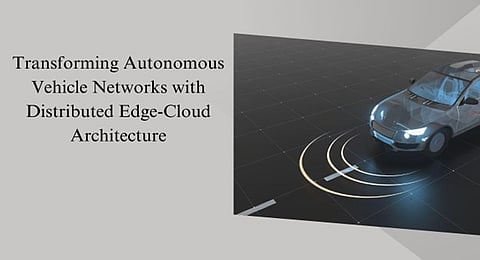

In distributed computing, the next leader has found a way in an innovative and groundbreaking approach towards optimizing real-time processing within an autonomous vehicle network. Konakanchi develops architecture addressing one of the core problems concerning latency, reliability, and scalability and is moving on towards the first step in even safer and efficient systems. In this way, the work propels the industry forward with transformative solutions that set new standards for autonomous vehicle technology. This article explores the key innovations of the design, emphasizing its impact on the future of intelligent transportation.
The design will have a hybrid architecture that absorbs the best of edge and cloud computing into a robust and efficient system. At the core of this architecture, the edge nodes are assigned the task of performing critical, time-sensitive operations such as obstacle detection and trajectory planning. The system aims for negligible latency while processing tasks locally with responses of under 5 milliseconds in order to achieve the goals of real-time applications. Such applications require prompt decision-making and execution.
This can also be due to the cloud architecture where such computationally intensive tasks are run and even the overall system optimization processes are coordinated with the network by constantly training the ML models in the back. Such an architecture by handing over these processes to the cloud helps in ensuring that the nodes at the edges do not lose focus on such immediate local functions by keeping up with the computational intensities.
This hybrid approach provides several benefits. It enhances the system's overall efficiency by distributing tasks based on their specific requirements, reduces operational delays, and maintains high levels of performance consistency. Furthermore, the centralized cloud framework facilitates scalability and adaptability, allowing for real-time updates to machine learning models and system configurations without disrupting edge operations. This dual-layered strategy will allow agility and the benefits of this edge computing technology while ensuring a scalable and more computationally effective system design from the cloud end.
The system combines data from LiDAR, radar, and camera sensors such that it forms a comprehensive perception model, making the overall accuracy of a decision substantially enhanced. The complex algorithms ensure successful tracking of the object 96.8% of the time, even when heavy rain or low visibility are prevailing conditions. With this powerful sensor fusion, the vehicle accurately understands and acts in response to sophisticated urban situations to ensure precise safety, effortless detection of obstacles, and predictable performance in changing scenarios.
The system includes a predictive AI model that integrates real-time traffic data with historical patterns to forecast traffic density and environmental factors with more than 89% accuracy. This allows for rapid re-optimization of vehicle routes to ensure seamless navigation through even the most congested urban areas. With computations finalized in under a second, the model enhances efficiency, minimizes delays, and improves overall traffic flow for a superior driving experience.
It has sophisticated security protocols to safeguard vulnerabilities in the autonomous network with the hybridizing of cryptographic methods, which are used to provide strong integrity and confidentiality for the data. Also, AI powers will detect the threat in real time, thereby identifying and neutralizing the possibility of cyberattacks within milliseconds; hence, emerging threats cannot pose any risk to the operations. The multi-layered security framework makes the network resilient but, more importantly, provides safety and reliability for the autonomous operation of vehicles in hostile and dynamic environments.
It can support up to 100,000 connected vehicles and has under 50 milliseconds latency for 98% of operations. The modularity supports easy scalability easily embracing future advancements such as 5G communications and edge AI accelerators. This makes the system future-proof in an industry that is always evolving.
Rigorous testing of the architecture will actually show improvements far surpassing that of the old system. Average latency is 16.5 milliseconds and has an operational availability of a phenomenal 99.982%. This further underlines how well the system is designed to work regardless of varied traffic and even severe weather.
This framework of the distributed edge cloud defines the new standards of the systems of the autonomous vehicle as it addresses fundamental challenges in areas related to real-time processing, security, and scalability.
Through such an advanced solution, there is a potential basis for safer, more reliable, and efficient transport networks.
This work of Sandeep Konakanchi has clearly shown that innovative architectures can revamp the world of autonomous vehicles. His contributions form a good base for developing the sector further, marking an important milestone on the path toward intelligent transportation.
